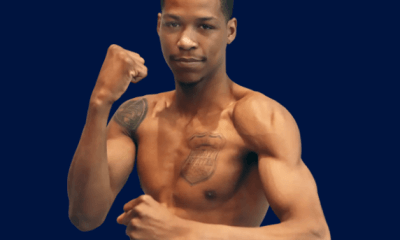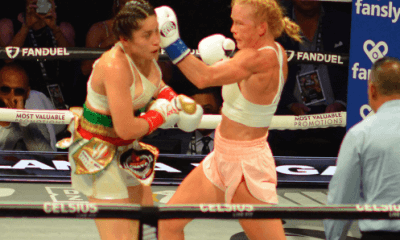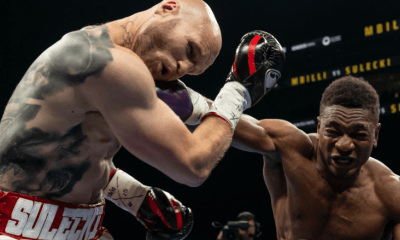Featured Articles
Notes and Nuggets from Thomas Hauser: Callum Walsh Returns to Madison Square Garden

On Sunday, March 16 (the night before St. Patrick’s Day), Callum Walsh continued his move up the junior-middleweight ranks with a brutal first-round knockout of Dean Sutherland at the Hulu Theatre at Madison Square Garden. The seven-bout card promoted by Tom Loeffler featured seven Irish boxers. Walsh stole the show but two non-Irish fighters on the undercard caught the eye.
In the third fight of the evening, Cletus Seldin (known as “The Hebrew Hammer) took on Yeis Gabriel Solano. The last time Seldin fought at Madison Square Garden (March 15, 2024), he took the ring announcer’s microphone after a majority-decision win, dropped to one knee, held out a diamond engagement ring, and asked one Jessica Ostrowski to marry him. The future Mrs. Seldin (who was clad in black leather) said yes, and the happy couple paraded around the ring together. They were married on September 7.
“So I’ve got a ring now,” Seldin says. “And I love married life because I love Jessica.”
A cynic at ringside on Sunday night wondered if Jessica might serve Cletus with a summons and complaint for divorce in the ring after the fight. Not to worry. The couple seems happily married and, after Seldin eked out a majority decision over Solano (now winless in five fights dating back to 2019), Cletus and Jessica announced in the ring that they’re expecting the birth of their first child.
In the next fight of the evening, Irish heavyweight Thomas Carty (255 pounds) brought a 10-0 (9 KOs) record into the ring to face 409-pound Dajuan Calloway (10-3, 9 KOs, 1 KO by).
Carty-Calloway was a poor match for a prospect. A fighter gets relatively little credit for beating a 400-pound opponent. And the problems posed by a physical confrontation with a 400-pound mountain are considerable.
With fifty seconds left in round two, Carty collapsed to the canvas as Calloway spun him around on the inside. Thomas rose, limping badly on a clearly-injured left knee. And referee Jamil Antoine foolishly allowed the bout to continue.
Carty tried to circle away, fell again. And Antoine – more foolishly – instructed the fighters to fight on. There was a third fall that the referee ruled a knockdown. The bell rang. And then the fight was stopped. It goes in the record book as a knockout at 3:00 of the second round.
Worse for Carty, he now appears to be facing surgery followed by a long rehabilitation. There’s no way to know how much further damage was done to his knee in the forty seconds that he was clearly impaired and under assault by a 409-pound man who was trying to knock him unconscious.
But the night belonged to 23-year-old Callum Walsh.
Walsh is from Cork, Ireland, trains in California with Freddie Roach, and came into the ring with a 12-0 (10 KOs) record.
“He’s a pretty good fighter,” Roach says. “He’s getting better. And he works his ass off in the gym.”
Equally important in an age when social media and hype often supersede a fighter’s accomplishments in the ring as the key to marketability. Walsh has the enthusiastic backing of Dana White.
Callum seems more at ease with the media now than when he fought at Madison Square Garden a year ago. And he has a new look. His hair is shorter and no longer dyed blond.
“It’s a new year, so time for a new look,” Walsh explained. Later, he added, “I don’t want to be a prospect anymore. I want to be a contender. I expected the road to be tough. I’ve never had anything easy in my life. I’ve worked as a fisherman. I’ve worked on a cargo ship. I like this job a lot more. They have big plans for me. But I still have to do my job.”
Sutherland, age 26, was born in Scotland and has lived there his entire life. He came to New York with a 19-1 (7 KOs, 1 KO by) record and, prior to fighting Walsh, noted, “I’m under no illusions. Fighting an Irishman on St. Patrick’s Day in New York; it’s all being built up for him. If it goes to the scorecards, no matter how the fight goes, I’m unlikely to get the decision. But when the bell rings, it will be only me and Callum. I’ve watched his fights. I’ve studied his habits and rhythm. I’ve been through hard fights. He’s untested. This is my big opportunity. I’m not here to be part of Callum’s record.”
Talking is easier than fighting. When the hour of reckoning came, Walsh was faster, stronger, better-skilled, and hit harder than Sutherland. Indeed, Callum was so dominant in the early going that round one had the look of a 10-8 round without a knockdown. Then Sutherland was flattened by a right hook at the 2:45 mark and any thoughts as to scoring became irrelevant.
It was Walsh’s best showing to date, although it’s hard to know the degree to which Sutheralnd’s deficiencies contributed to that showing. What’s clear is that Callum is evolving as a fighter. And he’s the kind of fighter who fits nicely with the concept that Turki Alalshikh and Dana White have voiced for a new boxing promotional company. Whether they’ll be willing to put Walsh in tough is an open issue. UFC puts its fighters in tough.
****
There was a void at ringside on Sunday night. After more than four decades on the job, George Ward is no longer with the New York State Athletic Commission.
Ward was the model of what a commission inspector should be. I watched him in the corner and in dressing rooms countless times over the years. A handful of inspectors were as good as he was. Nobody was better. Later, as a deputy commissioner, he performed the thankless back-of-the-house administrative duties on fight night while other deputy commissioners were enjoying the scene at ringside.
George and Robert Orlando (who, like George, is a former New York City corrections officer) also normally presided over pre-fight weigh-ins. That’s worth mentioning here because it ties to one of the more unfortunate incidents that occurred during the tenure of former NYSAC executive director Kim Sumbler.
On November 1, 2019, Kelvin Gastelum weighed in for a UFC 244 match against Darren Till to be contested at Madison Square Garden. The contract weight for the fight was 186 pounds. It was known throughout the MMA community that Gastelum had been having trouble making weight. Before stepping on the scale, he stripped down completely naked and a towel was lifted in front of him to shield his genitals from public view. Then, to everyone’s surprise, his weight was announced as 184 pounds (two pounds under the contract weight).
How did Gastelum make weight? Video of the weigh-in showed him resting his elbow on his coach as he stood on the scale.
Why am I mentioning this now?
Ward and Orlando know all the tricks. While they were readying for the Gastelum-Till weigh-in, Sumbler told them that they were being replaced on the scales by two other commission employees who had been brought to New York City from upstate. They asked why and were told, “Because I said so.”
George Ward was one of the behind-the-scenes people who make boxing work. He’ll be missed.
****
Six years ago, Gene Pantalone wrote a traditional biography of former world lightweight champion Lew Jenkins. Now he has written – shall we say – a creative biography of lightweight great Freddie Welsh.
Welsh was born in Wales in 1886 but spent most of his ring career in the United States. He captured the lightweight crown by decision over Willie Ritchie in 1914 and relinquished it to Benny Leonard three years later. BocRec.com credits him with a 74-5-7 (34 KOs) ring record in bouts that are verified and were officially scored. If “newspaper decisions” are added to the mix, the numbers rise to 121 wins, 29 losses, and 17 draws. Many of the losses came when Welsh was long past his prime. He’s on the short list of boxing’s greatest fighters. The only knock out he suffered was when he lost the title to Leonard.
Chasing The Great Gatsby is styled as a biography of Welsh and also an advocacy brief in support of the proposition that Welsh was the inspiration and model for the title character in F. Scott Fitzgerald’s seminal novel The Great Gatsby. I’m unsure how factually accurate Pantalone’s work is in some places. Also, too often, he uses big words when small ones will suffice. For example:
“He was a pugilistic virtuoso, a pummeling poet with fists of fury and a keen intellect. His duality was evident in every aspect of his being, an amalgamation of the vicious and the benevolent.”
Over the course of 349 pages, that weighs a reader down.
Still, there are some interesting observations and nuggets of information to be mined in Chasing The Great Gatsby. Among my favorites are Pantalone’s description of Jack Dempsey training for his historic 1921 fight against George Carpentier at a “health farm” that Welsh owned in New Jersey; Pantelone’s description of how the stadium that hosted Dempsey-Carpentier was built; and Pantalone’s evaluation of the fight itself, which he calls “a spectacle of titanic proportions,” before adding,” The truth was inescapable. The fight had not lived up to its grandeur, but the event did.”
****
Several of the books that Robert Lipsyte has written during his storied career as a journalist focus on boxing; most notably, Free to Be Muhammad Ali and The Contender (a young adult novel). Lipsyte’s most recent book – Rhino’s Run (published by Harper) – is a young adult novel keyed to high school football, not the sweet science. But the opening sentence bears repeating:
“Punching Josh Kremens didn’t feel as good as I thought it would, and I’d been thinking about it for five years.”
Be honest! Don’t you want to read more?
Thomas Hauser’s email address is thomashauserwriter@gmail.com. His most recent book – MY MOTHER and ME is a personal memoir available at Amazon.com. https://www.amazon.com/My-Mother-Me-Thomas-Hauser/dp/1955836191/ref=sr_1_1?crid=5C0TEN4M9ZAH&keywords=thomas+hauser&qid=1707662513&sprefix=thomas+hauser%2Caps%2C80&sr=8-1
In 2004, the Boxing Writers Association of America honored Hauser with the Nat Fleischer Award for career excellence in boxing journalism. In 2019, Hauser was selected for boxing’s highest honor – induction into the International Boxing Hall of Fame.
To comment on this story in the Fight Forum CLICK HERE
-

 Featured Articles3 weeks ago
Featured Articles3 weeks agoAvila Perspective, Chap. 330: Matchroom in New York plus the Latest on Canelo-Crawford
-

 Featured Articles2 weeks ago
Featured Articles2 weeks agoVito Mielnicki Jr Whitewashes Kamil Gardzielik Before the Home Folks in Newark
-

 Featured Articles4 weeks ago
Featured Articles4 weeks agoAvila Perspective, Chap 329: Pacquiao is Back, Fabio in England and More
-

 Featured Articles3 weeks ago
Featured Articles3 weeks agoOpetaia and Nakatani Crush Overmatched Foes, Capping Off a Wild Boxing Weekend
-

 Featured Articles2 weeks ago
Featured Articles2 weeks agoCatching Up with Clay Moyle Who Talks About His Massive Collection of Boxing Books
-

 Featured Articles4 weeks ago
Featured Articles4 weeks agoFabio Wardley Comes from Behind to KO Justis Huni
-

 Featured Articles1 week ago
Featured Articles1 week agoMore Medals for Hawaii’s Patricio Family at the USA Boxing Summer Festival
-

 Featured Articles4 weeks ago
Featured Articles4 weeks agoDelving into ‘Hoopla’ with Notes on Books by George Plimpton and Joyce Carol Oates





















